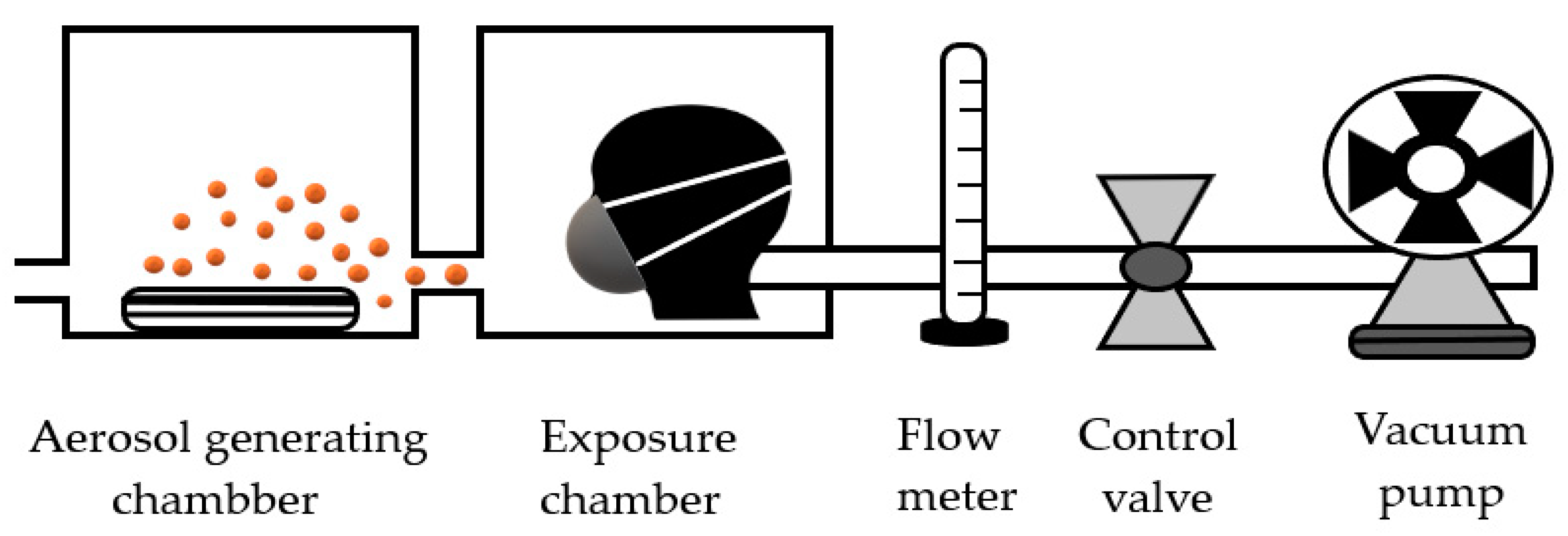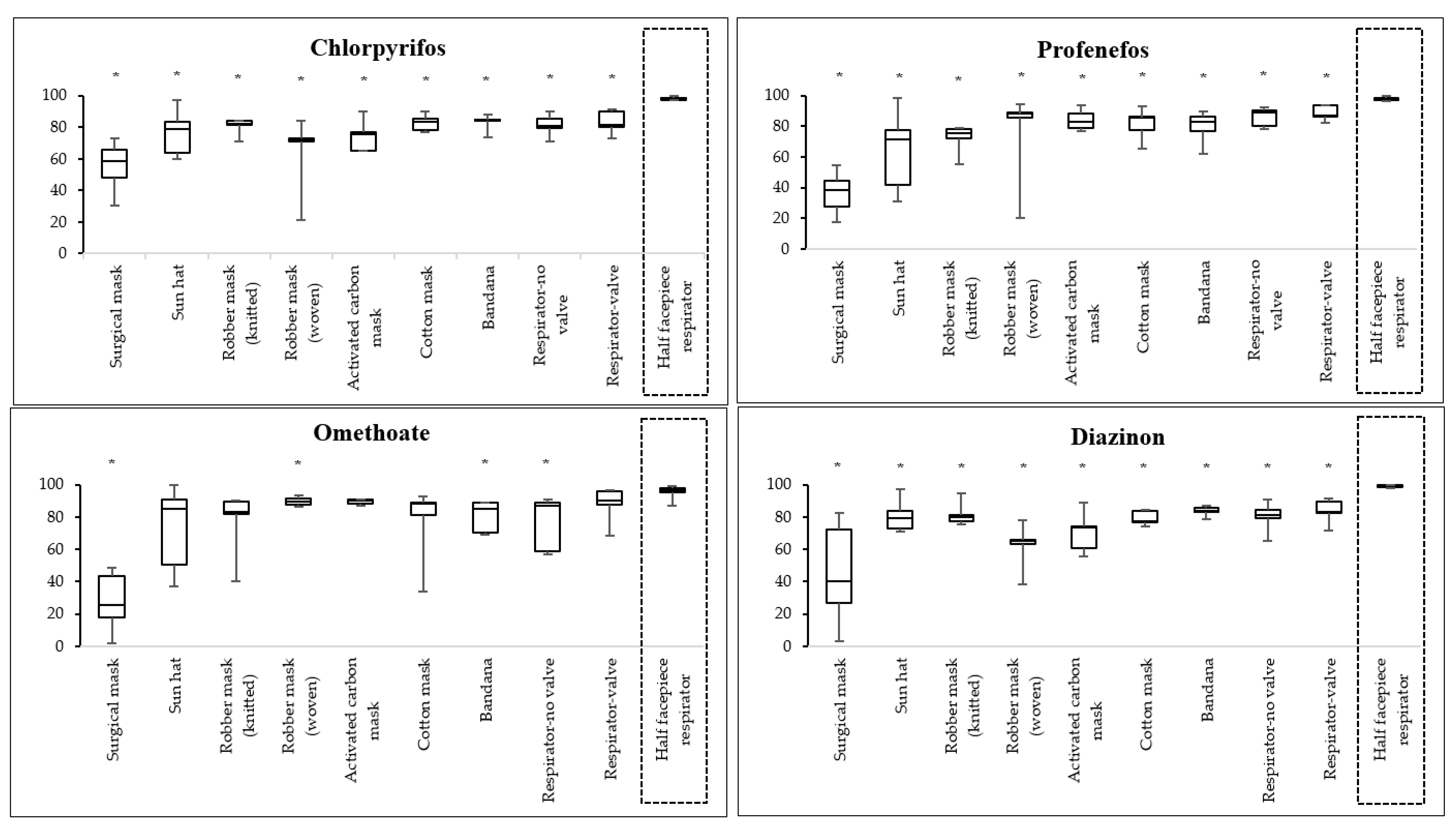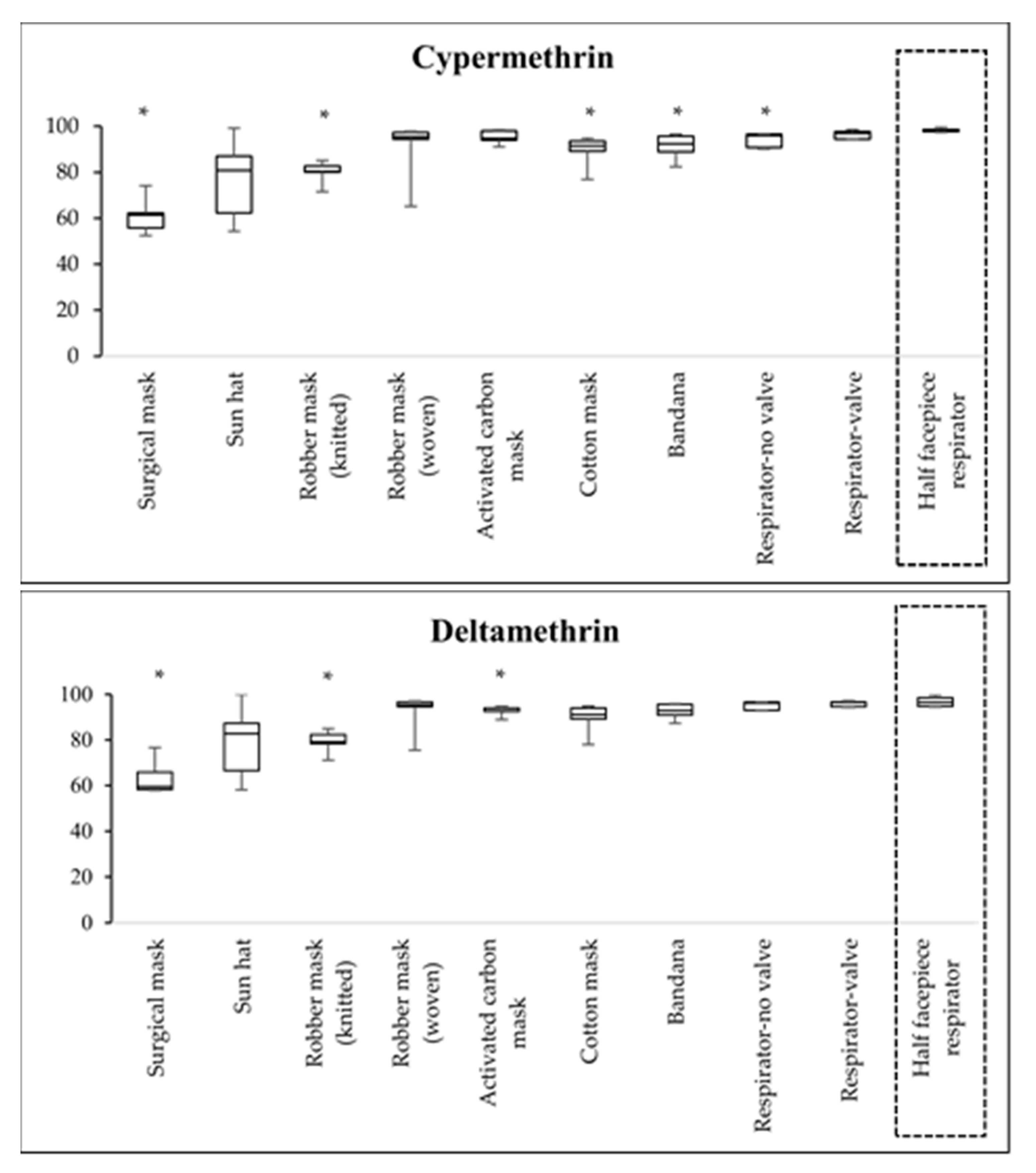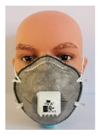Insecticide Filtration Efficiency of Respiratory Protective Equipment Commonly Worn by Farmers in Thailand
Abstract
1. Introduction
2. Materials and Methods
2.1. Tested RPE
2.2. Tested Insecticides
2.3. Experimental Design
2.4. Extraction and Analysis of Insecticides
2.5. Quality Control
2.6. Data Analysis
3. Results
3.1. Insecticide Concentrations in the Pad from Mannequin with and without RPE
3.2. Comparison of Insecticide Filtration Efficiency of Various RPE with Half Facepiece Respirator
4. Discussion
5. Conclusions
Author Contributions
Funding
Institutional Review Board Statement
Informed Consent Statement
Data Availability Statement
Acknowledgments
Conflicts of Interest
References
- Damalas, C.A.; Koutroubas, S.D. Farmers’ exposure to pesticides: Toxicity types and ways of prevention. Toxics 2016, 4, 1. [Google Scholar] [CrossRef] [PubMed]
- Kim, K.H.; Kabir, E.; Jahan, S.A. Exposure to pesticides and the associated human health effects. Sci. Total Environ. 2017, 575, 525–535. [Google Scholar] [CrossRef] [PubMed]
- Mamane, A.; Raherison, C.; Tessier, J.F.; Baldi, I.; Bouvier, G. Environmental exposure to pesticides and respiratory health. Eur. Respir. Rev. 2015, 24, 462–473. [Google Scholar] [CrossRef] [PubMed]
- Sapbamrer, R.; Seesen, M.A. systematic review of association between pesticide exposure and respiratory outcomes among farmers and farmworkers. Malays. J. Med. Health Sci. 2020, 16, 312–324. [Google Scholar]
- Ye, M.; Beach, J.; Martin, J.W.; Senthilselvan, A. Occupational pesticide exposures and respiratory health. Int. J. Environ. Res. Public Health 2013, 10, 6442–6471. [Google Scholar] [CrossRef]
- Food and Agriculture Organization of the United Nations (FAO); World Health Organization (WHO). International Code of Conduct on Pesticide Management Guidelines for Personal Protection When Handling and Applying Pesticides. Available online: http://www.fao.org/3/ca7430en/CA7430EN.pdf (accessed on 10 September 2020).
- US Environmental Protection Agency (US.EPA). How to Comply With the 2015 Revised Worker Protection Standard For Agricultural Pesticides What Owners and Employers Need To Know. Available online: http://www.pesticideresources.org/wps/htc/htcmanual.pdf (accessed on 2 October 2020).
- Sapbamrer, R.; Thammachai, A. Factors affecting use of personal protective equipment and pesticide safety practices: A systematic review. Environ. Res. 2020, 185, 109444. [Google Scholar] [CrossRef]
- Garrigou, A.; Laurent, C.; Berthet, A.; Colosio, C.; Jas, N.; Daubas-Letourmeux, V. Critical review of the role of PPE in the prevention of risks related to agricultural pesticide use. Saf. Sci. 2020, 123, 104527. [Google Scholar] [CrossRef]
- Food and Agriculture Organization of the United Nations (FAO). Family Farming Knowledge Platform. Available online: http://www.fao.org/family-farming/countries/tha/en/ (accessed on 15 November 2020).
- Food and Agriculture Organization of the United Nations (FAO). Country Fact Sheet on Food and Agriculture Policy Trends: Socio-Economic Context and Role of Agriculture. Available online: http://www.fao.org/3/I8683EN/i8683en.pdf (accessed on 15 November 2020).
- Visetnoi, S.; Sirisoponsilp, S. Uplifting Thailand’s agriculture through agricultural education: A paradigm shift for future farmers. IJAITG 2019, 1, 44–56. [Google Scholar] [CrossRef]
- Sapbamrer, R. Pesticide use, poisoning, and knowledge and unsafe occupational practices in Thailand. New Solut. 2018, 28, 283–302. [Google Scholar] [CrossRef]
- Hongsibsong, S.; Sittitoon, N.; Sapbamrer, R. Association of health symptoms with low-level exposure to organophosphates, DNA damage, AChE activity, and occupational knowledge and practice among rice, corn, and double-crop farmers. J. Occup. Health 2017, 59, 165–176. [Google Scholar] [CrossRef]
- Sematong, S.; Zapuang, K.; Kitana, N. Pesticide use, farmer knowledge and awareness in Thong Pha Phum region, Kanchanaburi Province. J. Health Res. 2008, 22, 15–20. [Google Scholar]
- Norkaew, S.; Siriwong, W.; Siripattanakul, S.; Robson, M.G. Knowledge, attitude, and practice (KAP) of using personal protective equipment (PPE) for chilli-growing farmers in Huarua Sub-District, Mueang District, Ubonrachathani Province, Thailand. J. Heath Res. 2010, 24, 83–86. [Google Scholar]
- Jintana, S.; Sming, K.; Krongtong, Y.; Thanyachai, S. Cholinesterase activity, pesticide exposure and health impact in a population exposed to organophosphates. Int. Arch. Occup. Environ. Health 2009, 82, 833–842. [Google Scholar] [CrossRef] [PubMed]
- Sapbamrer, R.; Nata, S. Health symptoms related to pesticide exposure and agricultural tasks among rice farmers from Northern Thailand. Environ. Health Prev. Med. 2014, 19, 12–20. [Google Scholar] [CrossRef] [PubMed]
- Plianbangchang, P.; Jetiyanon, K.; Wittaya-Areekul, S. Pesticide use patterns among small-scale farmers: A case study from Phitsanulok, Thailand. S. Asian J. Trop. Med. Public Health 2009, 40, 401–410. [Google Scholar]
- Konthonbut, P.; Kongtip, P.; Nankongnab, N.; Tipayamongkholgul, M.; Yoosook, W.; Woskie, S. Paraquat exposure of backpack sprayers in agricultural area in Thailand. Hum. Ecol. Risk Assess. 2019, 26. [Google Scholar] [CrossRef]
- The office of Agricultural Regulation, Department of Agriculture. Report of Hazardous Agricultural Chemical Imported into Thailand. Available online: https://www.doa.go.th/ard/wp-content/uploads/2020/02/HASTAT62_03.pdf (accessed on 5 July 2020).
- ISO 16900-3:2012. Respiratory Protective Devices. Methods of Test and Test Equipment-Part 3: Determination of Particle Filter Penetration. Available online: https://www.iso.org/standard/38876.html (accessed on 25 January 2020).
- Shakya, K.M.; Noyes, A.; Kallin, R.; Peltier, R.E. Evaluating the efficacy of cloth facemasks in reducing particulate matter exposure. J. Expo. Sci. Environ. Epidemiol. 2017, 27, 352–357. [Google Scholar] [CrossRef] [PubMed]
- Kooij, S.; Astefanei, A.; Corthals, G.L.; Bonn, D. Size distributions of droplets produced by ultrasonic nebulizers. Sci. Rep. 2019, 9, 6128. [Google Scholar] [CrossRef]
- Silverman, L.; Lee, G.; Plotkin, T.; Sawyers, L.A.; Yancey, A.R. Air flow measurement on human subjects with and without respiratory resistance at several work rates. AMA Arch. Ind. Hyg. Occup. Med. 1951, 3, 461–478. [Google Scholar] [PubMed]
- US Environmental Protection Agency (US.EPA). Exposure Factors Handbook 2011 Edition (Final Report). Available online: https://cfpub.epa.gov/ncea/risk/recordisplay.cfm?deid=236252 (accessed on 10 September 2020).
- Laird, I.S.; Goldsmith, R.; Pack, R.J.; Vitalis, A. The effect on heart rate and facial skin temperature of wearing respiratory protection at work. Ann. Occup. Hyg. 2002, 46, 143–148. [Google Scholar] [CrossRef]
- Sapbamrer, R.; Hongsibsong, S. Organophosphorus pesticide residues in vegetables from farms, markets, and a supermarket around Kwan Phayao Lake of Northern Thailand. Arch. Environ. Contam. Toxicol. 2014, 67, 60–67. [Google Scholar] [CrossRef]
- Pakvilai, N.; Prapamontol, T.; Thavornyutikarn, P.; Hongsibsong, S.; Santasup, C. A simple and sensitive GC-ECD method for detecting synthetic pyrethroid insecticide residues in vegetable and fruit samples. CMU J. Sci. 2015, 42, 197–208. [Google Scholar]
- The National Academies. Chapter: 2 Characteristics of Respirators and Medical Masks. In Reusability of Facemasks During an Influenza Pandemic: Facing the Flu; The National Academies Press: Washingto1n, DC, USA, 2006; pp. 22–41. Available online: https://www.nap.edu/read/11637/chapter/1#ii (accessed on 20 November 2020).
- Kalderis, D.; Bethanis, S.; Paraskeva, P.; Diamadopoulos, E. Production of activated carbon from bagasse and rice husk by a single-stage chemical activation method at low retention times. Bioresour. Technol. 2008, 99, 6809–6816. [Google Scholar] [CrossRef]
- Khayan, K.; Anwar, T.; Wardoyo, S.; Lakshmi Puspita, W. Active carbon respiratory masks as the adsorbent of toxic gases in ambient air. J. Toxicol. 2019, 2019, 5283971. [Google Scholar] [CrossRef]
- Mohan, A.V.; Bhaarathidhurai, D. Activated carbon-a textile material. Int. J. Innov. Res. Sci. Eng. Technol. 2020, 5, 829–832. [Google Scholar]
- Penconek, A.; Drazyk, P.; Moskal, A. Penetration of diesel exhaust particles through commercially available dust half masks. Ann. Occup. Hyg. 2013, 57, 360–373. [Google Scholar] [CrossRef]
- Føreland, S.; Robertsen, Ø.; Hegseth, M.N. Do various respirator models fit the workers in the Norwegian smelting industry? Saf. Health Work 2019, 10, 370–376. [Google Scholar] [CrossRef] [PubMed]
- Bellin, P.; Hinds, W.C. Aerosol penetration through respirator exhalation valves. Am. Ind. Hyg. Assoc. J. 1990, 51, 555–560. [Google Scholar] [CrossRef]
- Roberge, R.J. Are exhalation valves on N95 filtering facepiece respirators beneficial at low-moderate work rates: An overview. J. Occup. Environ. Hyg. 2012, 9, 617–623. [Google Scholar] [CrossRef] [PubMed]
- Mueller, W.; Horwell, C.J.; Apsley, A.; Steinle, S.; McPherson, S.; Cherrie, J.W.; Galea, K.S. The effectiveness of respiratory protection worn by communities to protect from volcanic ash inhalation. Part I: Filtration efficiency tests. Int. J. Hyg. Environ. Health 2018, 221, 967–976. [Google Scholar] [CrossRef] [PubMed]
- Pacitto, A.; Amato, F.; Salmatonidis, A.; Moreno, T.; Alastuey, A.; Reche, C.; Buonanno, G.; Benito, C.; Querol, X. Effectiveness of commercial face masks to reduce personal PM exposure. Sci. Total Environ. 2019, 650 Pt 1, 1582–1590. [Google Scholar] [CrossRef]
- Gohl, E.P.G.; Vilensky, L.D. Textiles for Modern Living, 5th ed.; Longman Cheshire: Melbourne, Australia, 1993. [Google Scholar]
- Lee, S.; Obendorf, S.K. Statistical model of pesticide penetration through woven work clothing fabrics. Arch. Environ. Contam. Toxicol. 2005, 49, 266–273. [Google Scholar] [CrossRef] [PubMed]
- Zhang, X.; Raheel, M. Statistical model for predicting pesticide penetration in woven fabrics used for chemical protective clothing. Bull. Environ. Contam. Toxicol. 2003, 70, 652–659. [Google Scholar] [CrossRef] [PubMed]
- Lepelletier, D.; Keita-Perse, O.; Parneix, P.; Baron, R.; Glele, L.S.A.; Grandbastien, B.; French Society for Hospital Hygiene working. Respiratory protective equipment at work: Good practices for filtering facepiece (FFP) mask. Eur. J. Clin. Microbiol. Infect. Dis. 2019, 38, 2193–2195. [Google Scholar] [CrossRef] [PubMed]
- Steinle, S.; Sleeuwenhoek, A.; Mueller, W.; Horwell, C.J.; Apsley, A.; Davis, A.; Cherrie, J.W.; Galea, K.S. The effectiveness of respiratory protection worn by communities to protect from volcanic ash inhalation. Part II: Total inward leakage tests. Int. J. Hyg. Environ. Health 2018, 221, 977–984. [Google Scholar] [CrossRef]



| Type of RPE | Description | |
|---|---|---|
| Surgical mask |  | -a standard surgical mask available from pharmacies -made of non-woven material (4 layers), has a nose bridge strip -disposable (single use) -thickness 0.557 ± 0.005 mm -price 0.17–0.33 USD |
| Sun hat |  | -made of cotton woven fabric -available from rural markets in Thailand -reusable -thickness 0.306 ± 0.004 mm -price 2.65–2.98 USD |
| Robber mask (woven fabric) |  | -made of cotton woven fabric -available from rural markets in Thailand -reusable -thickness 0.555 ± 0.006 mm -price 2.15–2.48 USD |
| Robber mask (knitted fabric) |  | -made of cotton knitted fabric -available from rural markets in Thailand -reusable -thickness 1.508 ± 0.452 mm -price 1.49–1.98 USD |
| Activated carbon mask |  | -a standard surgical mask available from pharmacies -made of non-woven material (4 layers), has a nose bridge strip -disposable (single use) -thickness 0.487 ± 0.001 mm -price 0.17–0.33 USD |
| cotton mask |  | -made of cotton woven fabric -available from markets in Thailand -reusable -thickness 0.577 ± 0.002 mm -price 0.49–0.66 USD |
| Bandana |  | -made of cotton woven fabric -farmers usually fold into quadruple layers when using -available from markets in Thailand -reusable -thickness 1.467 ± 0.009 mm -price 3.96–4.96 USD |
| Organic vapor respirator without valve |  | -a certified disposal respirator by 3M (8247) -meets NIOSH 42 CFR84 (R95) -made of non-woven material -has a nose bridge strip -5 layers: polyester layer, polypropylene layer, activated carbon layer, and 2 polypropylene layers -available from 3M distributor -disposable (single use) -price 3.14 USD |
| Organic vapor respirator with valve |  | -a certified disposable respirator with valve by 3M (9913V) -meets the requirements of Australian/ New Zealand Standard (AS/NZS 1716:2012) (GP1) -made of non-woven material -has a nose bridge strip -5 layers: polyester layer, polypropylene layer, activated carbon layer, and 2 polypropylene layers -available from 3M distributor -disposable (single use) -price 3.27 USD |
| Half facepiece respirator |  | -half facepiece respirator 7502 by 3M (7502) -cartridge 60926 (multi-gas/vapor cartridge) -meets NIOSH 42 CFR84 (P100) -face seal, inhalation and exhalation valve made with silicone rubber -available from 3M distributor -reusable -price 125.50 USD |
| Types of Insecticides | LOD (μg) | LOQ (μg) | %Recovery |
|---|---|---|---|
| Chlorpyrifos | 0.0020 | 0.0200 | 110.6 |
| Profenofos | 0.0050 | 0.0500 | 89.7 |
| Omethoate | 0.1000 | 0.5000 | 97.9 |
| Diazinon | 0.0010 | 0.0100 | 98.4 |
| Cypermethrin | 0.0010 | 0.0100 | 110.6 |
| Deltamethrin | 0.0010 | 0.0100 | 87.6 |
| Insecticide | No Mask | Surgical Mask | Sun Hat | Robber Mask (Woven) | Robber Mask (Knitting) | Activated Carbon Mask | Cotton Mask | Bandana | Respirator-No Valve | Respirator-Valve | Half Facepiece Respirator | |
|---|---|---|---|---|---|---|---|---|---|---|---|---|
| Chlorpyrifos | Mean | 0.581 | 0.261 | 0.136 | 0.207 | 0.114 | 0.149 | 0.101 | 0.0997 | 0.109 | 0.0971 | 0.012 |
| SD. | 0.14 | 0.097 | 0.088 | 0.143 | 0.033 | 0.060 | 0.032 | 0.033 | 0.042 | 0.043 | 0.006 | |
| Median | 0.53 | 0.24 | 0.124 | 0.161 | 0.106 | 0.143 | 0.099 | 0.092 | 0.111 | 0.107 | 0.012 | |
| Profenofos | Mean | 0.405 | 0.258 | 0.146 | 0.101 | 0.114 | 0.065 | 0.075 | 0.084 | 0.057 | 0.047 | 0.009 |
| SD. | 0.192 | 0.059 | 0.111 | 0.126 | 0.039 | 0.028 | 0.043 | 0.044 | 0.026 | 0.021 | 0.005 | |
| Median | 0.393 | 0.250 | 0.116 | 0.048 | 0.100 | 0.070 | 0.058 | 0.069 | 0.045 | 0.054 | 0.011 | |
| Omethoate | Mean | 2.22 | 1.500 | 0.606 | 0.668 | 0.515 | 0.234 | 0.514 | 0.432 | 0.524 | 0.272 | 0.109 |
| SD. | 1.03 | 0.287 | 0.610 | 0.976 | 0.465 | 0.040 | 0.544 | 0.223 | 0.379 | 0.257 | 0.106 | |
| Median | 2.4 | 1.620 | 0.328 | 0.252 | 0.381 | 0.222 | 0.258 | 0.326 | 0.294 | 0.218 | 0.079 | |
| Diazinon | Mean | 2.37 | 1.310 | 0.455 | 0.890 | 0.438 | 0.700 | 0.490 | 0.392 | 0.471 | 0.389 | 0.028 |
| SD. | 0.461 | 0.776 | 0.250 | 0.323 | 0.178 | 0.310 | 0.109 | 0.074 | 0.222 | 0.187 | 0.017 | |
| Median | 2.34 | 1.420 | 0.496 | 0.834 | 0.484 | 0.636 | 0.532 | 0.396 | 0.452 | 0.402 | 0.027 | |
| Cypermethrin | Mean | 0.523 | 0.203 | 0.122 | 0.052 | 0.105 | 0.025 | 0.057 | 0.046 | 0.031 | 0.019 | 0.009 |
| SD. | 0.322 | 0.043 | 0.096 | 0.073 | 0.027 | 0.016 | 0.038 | 0.030 | 0.017 | 0.010 | 0.005 | |
| Median | 0.487 | 0.202 | 0.100 | 0.024 | 0.103 | 0.027 | 0.044 | 0.040 | 0.021 | 0.016 | 0.010 | |
| Deltamethrin | Mean | 0.0349 | 0.0127 | 0.0073 | 0.0028 | 0.0072 | 0.0026 | 0.0037 | 0.0026 | 0.0017 | 0.0015 | 0.0011 |
| SD. | 0.0208 | 0.0028 | 0.0058 | 0.0032 | 0.0019 | 0.0008 | 0.0024 | 0.0012 | 0.0007 | 0.0005 | 0.0012 | |
| Median | 0.034 | 0.0142 | 0.0060 | 0.0016 | 0.0073 | 0.0025 | 0.0031 | 0.0025 | 0.0013 | 0.0012 | 0.0009 |
Publisher’s Note: MDPI stays neutral with regard to jurisdictional claims in published maps and institutional affiliations. |
© 2021 by the authors. Licensee MDPI, Basel, Switzerland. This article is an open access article distributed under the terms and conditions of the Creative Commons Attribution (CC BY) license (http://creativecommons.org/licenses/by/4.0/).
Share and Cite
Sapbamrer, R.; Hongsibsong, S.; Naksata, M.; Naksata, W. Insecticide Filtration Efficiency of Respiratory Protective Equipment Commonly Worn by Farmers in Thailand. Int. J. Environ. Res. Public Health 2021, 18, 2624. https://doi.org/10.3390/ijerph18052624
Sapbamrer R, Hongsibsong S, Naksata M, Naksata W. Insecticide Filtration Efficiency of Respiratory Protective Equipment Commonly Worn by Farmers in Thailand. International Journal of Environmental Research and Public Health. 2021; 18(5):2624. https://doi.org/10.3390/ijerph18052624
Chicago/Turabian StyleSapbamrer, Ratana, Surat Hongsibsong, Manoch Naksata, and Wimol Naksata. 2021. "Insecticide Filtration Efficiency of Respiratory Protective Equipment Commonly Worn by Farmers in Thailand" International Journal of Environmental Research and Public Health 18, no. 5: 2624. https://doi.org/10.3390/ijerph18052624
APA StyleSapbamrer, R., Hongsibsong, S., Naksata, M., & Naksata, W. (2021). Insecticide Filtration Efficiency of Respiratory Protective Equipment Commonly Worn by Farmers in Thailand. International Journal of Environmental Research and Public Health, 18(5), 2624. https://doi.org/10.3390/ijerph18052624







